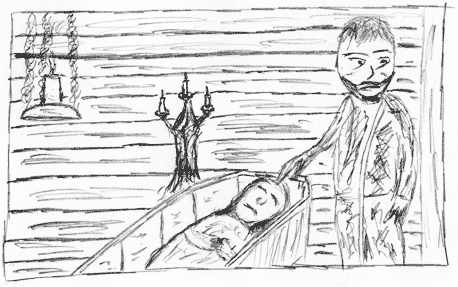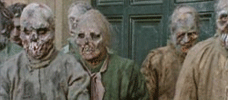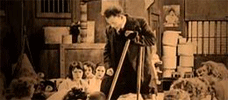Reviews
The Living Dead at Manchester Morgue / Don’t Open the Window / No Profanor El Sueno De Los Muertos
Jorge Grau
Spain / Italy, 1974
Credits
Review by Thomas Scalzo
Posted on 05 October 2007
Source Blue Underground DVD
Related articles
Reviews The Nights of Terror
Reviews City of the Living Dead
Reviews Night of the Creeps
Categories 31 Days of Horror
Alien zombies. Nazi zombies. Aquatic zombies. Invisible zombies. Blind zombies. Fetus zombies. Redneck zombies. Desert zombies. Ninja zombies. Call-girl zombies. Biker zombies. Confederate zombies. Screaming zombies. Equestrian zombies. Domesticated zombies…
Redefined time and again, the zombie is the most mutable of movie monsters, its inherent lack of definitive characteristics making it the perfect choice for filmmakers in search of a unique, but recognizable, fright-flick fiend. For whether they are vapid voodoo victims, enraged entrail-eaters, or comatose cranium-craving corpses, the zombie can be whatever you want it to be.
Beginning today, and continuing over the next three Fridays, we shall examine a quartet of zombie films that have each made a unique contribution to the ever-changing lore of the zombie. Although attention will certainly be devoted to examinations of story and cinematic technique, we shall pay particular heed to the variety of zombie we are dealing with - what they look like and how they came to be, how and why they kill, what sort of world they inhabit - and how the characteristics of the undead determines the zombie film experience.
One of the great joys of watching zombie movies is uncovering the reasons behind the revenants, the explanations invented by filmmakers to justify the incorporation of the living dead into their pictures. Our first film blames radiation, a common zombie origin rationalization that has been used for decades. But this is no ordinary radiation: it’s ultrasonic radiation. Nervous system-enraging ultrasonic radiation to be precise. Of course, the hapless humans doling out the deadly waves didn’t intend to reanimate the dead…
The troubles begin when members of a bucolic English town invent a machine to control a problematic insect population. Mounted on a truck and capable of casting a mile-wide net of radiation, the contraption does not kill the offending critters outright, but instead infuriates them to such a degree that they kill each other. Brilliant. As the initial tests are successful, it seems the perfect solution to pestilence. But when a pair of wayward travelers happens upon the town, and is assaulted by a pale-faced man stalking the countryside in hopes of sating his volcanic rage, we realize that human beings are also susceptible to the rage-inducing rays. At least the dead ones.
According to the science espoused in the film, as the human life ends, its nervous system reverts to that of a simple organism, such as a plant or an insect. If a person in such a state should come in contact with, say, ultra-sonic radiation designed to agitate simple nervous systems, corporeal death will shortly be followed by reanimation. And though the reanimated being is sadly bereft of higher brain function, it is still capable of simple tasks, and is fueled by an insatiable rage towards non-zombified humans. (It should be mentioned here that unborn children can be similarly affected by the radiation, and, in a moment which is nearly lost among the glorious zombie butchery, an enraged newborn claws out the eye of an attending nurse. However, as this infuriated infant is merely angry and not a zombie, we shall speak of him no more.)
Now here’s where things get complicated, and awesome.
After his initial contact with the travelers, and a quick bit of killing at a nearby farmhouse, the lone zombie (named Guthrie) makes his way to the local cemetery, possibly in search of others like himself. When all he discovers are stone-dead corpses, the enterprising ghoul takes it upon himself to reanimate them by smearing their faces with the blood of the living. (How this miraculous transformation occurs, or how the lone zombie’s rage is passed on to his creations, is never adequately explained, but the audacity of including a second origins explanation, not to mention the gusto of the resultant zombies, is more than enough to offset any logical inconsistencies.)
In and of itself, the idea of zombies engendering zombies is nothing new; as most mythologies of the undead take it as given that anyone eaten by a zombie becomes a zombie. But the act of a zombie deliberately and methodically creating other zombies is a genre rarity, and creates an impressive, and horrific, intimacy with the undead. For through the eyes of the snooping travelers, who find themselves trapped in a corner of the mortuary basement, we witness the lone zombie lovingly apply the blood to the faces of his chosen, watch in horror as they open their eyes, and recoil in fear as they crawl out of their coffins.
That these zombies are connected, not only by their zombiedom, but by their common creator, heightens the horror of the situation immensely, as our heroes must overcome, not just zombies, but zombies that work as a team. Instead of each thudding mindlessly against the cottage walls, for instance, they collectively unearth a weighty crucifix and wield it as a battering ram. And when one goes in for the kill, the others circle behind the victim to prevent any chance of escape. Grau’s use of disturbing point of view close-ups and an eerie soundtrack of zombie screams emanating from all directions, considerably enhance the sensation that no matter where you turn, the zombies are there.
Despite these tactical advantages, the overall number of zombies remains small, and the plague remains localized—so much so that the local law enforcement does not believe the wayward travelers’ account of the living dead. Surely there must be another explanation for the recent rash of murders, and more than likely, the pot-smoking, Satan-worshiping, inappropriately hirsute travelers are to blame. That the action of the film takes place, not in an anarchic, apocalyptic land, but in a world of law and order, adds a secondary threat to our heroes—for not only are they beset by zombies at every turn, they also face the threat of police who want to pin the deaths on them.
When considered in light of subsequent decades of horror creations, this subplot classes the film as an unsung predecessor of the slasher genre. For even though the zombie factor was largely absent from the superstar serial killer pictures of the ’80s, several story elements here - including authority figures disbelieving youth, a quiet town rocked by violent murders, and a relentless embodiment of evil - are slasher staples. And though Grau’s dead-eyed monsters certainly owe a debt to their own cinematic ancestors (most notably, Romero’s Night of the Living Dead ghouls), Let Sleeping Corpses Lie is nevertheless a unique and significant entry in the zombie cannon, crafted by a director at once reverently building on the master’s work, and confidently taking the genre in new directions.

Guthrie Wakes the Dead
More 31 Days of Horror
-

Alien
1979 -

The Elephant Man
1980 -

My Bloody Valentine
1981 -

Who Can Kill a Child?
1976 -

Cannibal Holocaust
1980 -

Let Sleeping Corpses Lie
1974 -

John Carpenter’s Vampires
1998 -

Jaws 2
1978 -

A Warning to the Curious
1972 -

Wolf
1994 -

The Survivor
1981 -

Cannibal Ferox
1981 -

The Nights of Terror
1981 -

Death Becomes Her
1992 -

Alice, Sweet Alice
1976 -

Body Double
1984 -

Invocation of My Demon Brother
1969 -

Phantasm II
1988 -

Emanuelle and the Last Cannibals
1977 -

The Wicker Man
1973 -

Maniac Cop
1988 -

The Legend of the 7 Golden Vampires
1974 -

The Penalty
1920 -

Boxing Helena
1993 -

Chew on This
2005 -

Night of the Creeps
1986 -

Night of the Lepus
1972 -

Near Dark
1987 -

Army of Darkness
1992 -

The Brood
1979 -

The Lift
1983 -

Amsterdamned
1988 -

Silent Witness
1999 -

The Shaft
2001
We don’t do comments anymore, but you may contact us here or find us on Twitter or Facebook.



